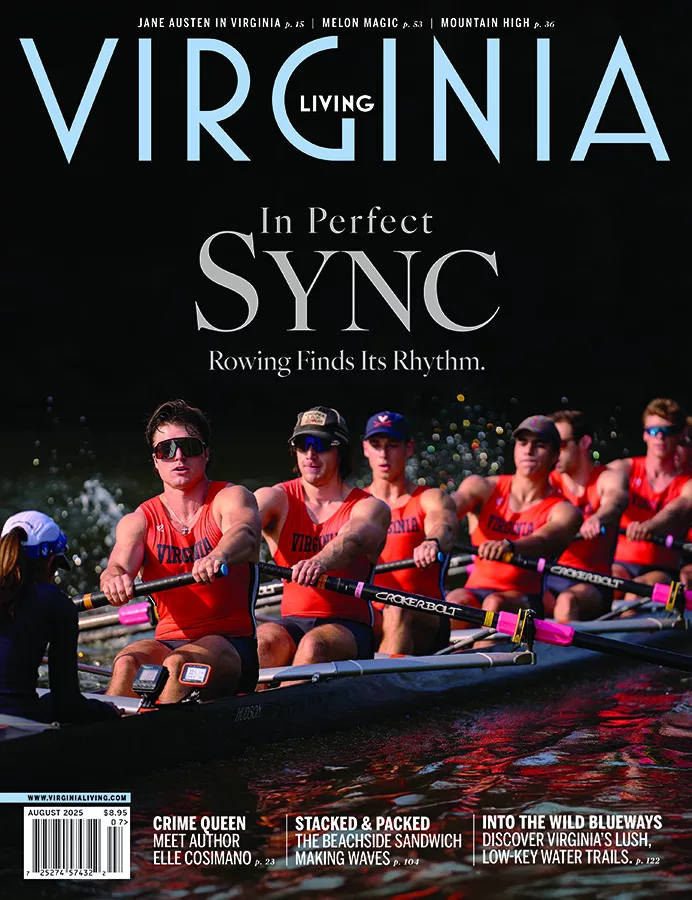Behind the scenes at the Garden Club of Virginia’s annual Daffodil Show.

“76 Trombones” is a Mille Fleurs-style arrangement created by Leesburg Garden Club member Ingeborg Bock.
Photography by Adam Ewing
In March 2019, Lucy Wilson had cut and collected all of the best daffodil blooms from her Martinsville home garden and was heading to Richmond for the Garden Club of Virginia’s 85th annual Daffodil Show. An early spring cold snap had limited her choices. “I needed one more good white,” she recalls. Resigned to making do with what she had found, she and her husband, A.C., headed down the driveway. Then she saw it. She yelled at A.C. to stop and quickly got out to cut the white bloom that would complete her entry of 12 perfect all-white daffodils and earn her the show’s coveted Mary McDermott Beirne Challenge Bowl. “I had been trying to win this award,” says Wilson. “And I finally won, thanks to that last-minute white!”

Judges reviewing the horticultural entries.
A member of the Martinsville Garden Club since 1973, Wilson isn’t alone in her passion for daffodils. More than 100 fellow enthusiasts representing 47 Garden Club of Virginia affiliated clubs compete in the show each year. The Virginia gardeners infected with what Wilson jokingly refers to as “yellow fever” and have gathered for 85 years to compete at the show sponsored by the Garden Club of Virginia and the American Daffodil Society.

More than 1,400 single stems ready for judging.
There are a staggering 30,000 varieties of daffodils, a bulb-forming plant native to northern Europe but grown around the world. Although mostly known for its distinctive yellow color and trumpet shape, daffodils also grow in white and even orange-tinged varieties. A narcissus in the amaryllis family, the daffodil has almost as many faces as it has fans. Full of ruffles like a peony or wide and flat like a tiny bowl against its petal backdrop, the daffodil trumpet ranges from dramatic to cool and laid back.

Certified daffodil judges Pat Filer, Lou Johnson, and Joyce Moorman.
So perhaps it makes sense that, of the show’s three competitive categories, or “schedules,” the largest is the horticultural competition; it draws about 700 entries every year. In the competition room, around 1,500 daffodil stems fill vases or, depending on size, tiny glass test tubes supported by wooden blocks. Nestled with sprigs of yew or other evergreens, they are placed on long risers in groupings based on shape, size, and color. Blue, red, and yellow ribbons are awarded to both single and multi-stem entries, while silver bowls, cups, and trophies honor the winners of a select few show awards and categories, including Lucy Wilson’s grouping of perfect white flowers.
“Members who compete in the show really want to win,” says two-time show chairman Adele Smith, a member of the Garden Club of the Middle Peninsula. They also love daffodils. “For many it’s because their mother or grandmother was a grower, or others who simply fell in love with the flower and the competition,” Smith says.

Bridgett Bryant of Dolley Madison Garden Club in Orange.
“My favorite part of the show is the hustle before the doors open for judging the blooms. The workroom where we prepare our entries is like a quiet war zone,” says Bobbi Oldham, a member of the Hillside Garden Club who has been participating in the show since 2014. “We have to hurry to ready the blooms, identify them properly, and display them to their best advantage.” Adds Dianne Spence, a member of the Garden Club of Gloucester, who has been cultivating daffodils since the late 1970s, “It’s like old home week. Everyone is so supportive and encouraging, especially to those who have never been to a show.”

Noni Baruch of Richmond’s James River Garden Club.
Members groom their entries according to the 10-page guidelines for exhibiting and judging club horticulture. The rules address details like the use of leaf polish (a no-no) and removal of “dust, dirt, pollen or spray” … something that plagued Albemarle Garden Club member Colleen Bassett in 2019. Wearing a visor and headlamp, and armed with a damp cotton swab, Bassett delicately removed dirt from a daffodil cup with just minutes to spare before the judging began. Other competitors gently massaged blooms to get just the right posture. The competitive spirit is palpable.
Explains Wendy Walker, chairman of the horticulture division and a member of the Garden Club of the Eastern Shore, “The entries have to be at their peak on show day, and in March in Virginia, the weather is rarely perfect for timing.” Because it was colder than usual in 2019, says Walker, competitors “put their stems on radiators and portable heaters to get them open.” On the other hand, says Spence, “Those in other parts of our state may have an advantage over those of us in Tidewater if we’ve had a particularly warm March, because most of our daffodils have already bloomed out.”

Entries in the artistic design competition.
Primping ends promptly at 10:15 a.m. Everyone clears the room for judging by officials from the American Daffodil Society. Six teams of three judges each move quietly through the rows of daffodil specimens with clipboards in hand, closely inspecting every stem before assigning a ribbon to the entry. When they are done, entrants flood the narrow aisles and excitedly congratulate each other’s victories. Jane Vaughan was bursting with pride when she saw the award on her sister Lucy Wilson’s white flowers: “She won! Lucy’s been trying to win that award for five years.”

Size matters in design categories.
If the daffodil show were a fireworks display, the grand finale would be just down the hall in a room packed with people. In contrast to the stark, simple beauty of the single stems showcased in the horticultural competition, here large vases explode with daffodils and other magnificent spring blooms in a riot of color and texture, all arranged to match various show criteria. Thirty-eight contemporary and traditional arrangements illustrate themes like “Pathways to Bloom” and “Victorian Ensemble.” The artistic design division encompasses both group and individual entries. Competitors are encouraged to use flowers grown in their own gardens but may supplement their entries with purchased materials; daffodils must predominate. The names and sources of flowers in each arrangement are listed on a card at the base of the entry.

Janet Hickman
“We make it, take it apart, and then bring it to Richmond to reassemble,” explains Walker from the Garden Club of the Eastern Shore.
Her club’s entry, “March of the Batons,” won the top prize in the “Parallel” category at the 2019 show. The club’s creation—three twirling batons festooned with foliage and orange and white daffodils mounted in upright parallel form—earned the judge’s highest marks.
“The show is fun,” concludes Janet Hickman, a member of the Hillside Garden Club in Lynchburg, winner of scores of ribbons, and the Garden Club of Virginia’s daffodil chairman. “There are a lot of reasons we enjoy this. It’s a bit of showing off for our friends, but we love these flowers. We are passionate about daffodils, and just like people who love tennis don’t do it to spend hours on end hitting balls against a backboard, we want to be out with other people who understand. It’s nice to go and talk daffodils to other people.” GCVirginia.org/DaffodilDay

Single blooms.
Daffodil Facts and Tips
Courtesy of the Garden Club of Virginia.

Entries in the “Parallel” category must feature flowers arranged in at least three parallel lines.
• Daffodils and narcissus are two names for the same flower. While some parts of the country also call these flowers jonquils, that name actually refers to a different species.
• A gift of daffodils is supposed to ensure good luck—but be sure to give an entire bunch, because legend has it that a single flower will bring misfortune.
• Daffodils are the official 10th wedding anniversary flower and are supposed to represent the simple pleasures a couple shares.
• Daffodils can flower from six weeks to six months, depending on where you live and the cultivars you grow.
• After blooming, let a daffodil rebuild its bulb for the next year. The leaves stay green while this is happening. When the leaves begin to yellow, you can cut them off.

David Vaughan of Lynchburg’s Hillside Garden Club.
• After cutting daffodils, soak the stems separately for at least six hours before mixing with other flowers in an arrangement. Daffodils give off a sap that can be deadly to other flowers, but conditioning removes the sap.
• Daffodils are a cheerful addition to the garden and are one of the few plants deer usually won’t eat. However, the bulbs contain poisonous alkaloids that can sicken pets. If your dog eats a bulb, call your vet or a pet poison helpline immediately.
For more helpful information, including growing guides and a calendar of flower festivals, visit DaffodilUSA.org.
This article originally appeared in our April 2020 issue.








